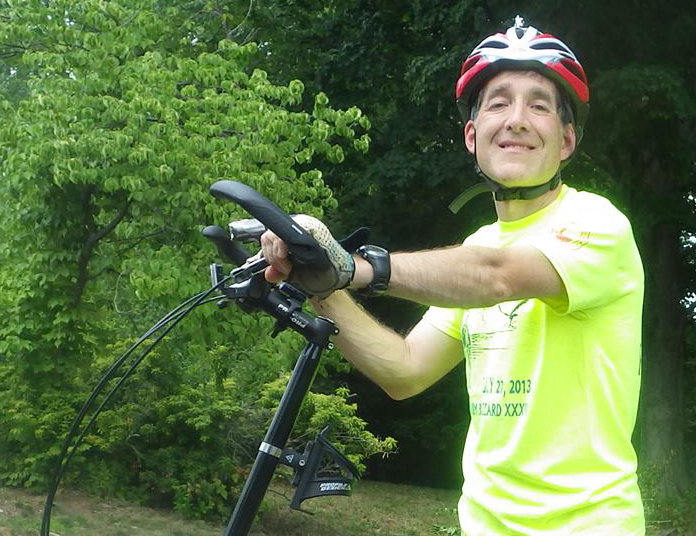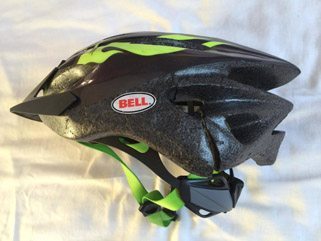“Skid lid.” “Brain bucket.”
The underlying meaning of these colorful slang terms for “bicycle helmet” is clear; You can fall, and if you do, you can suffer serious damage to your head.
A lively, mostly one-sided discussion occurred recently on the private ElliptiGO Facebook page when one owner asked, “How many of you wear a helmet when riding on carless paths?”

Todd Brown sporting his “brain bucket”
Many of us grew up riding bikes helmetless around the neighborhood. It wasn’t until Bell introduced the Li’l Bell Shell in 1984 that bike helmets started to become standard gear for kids. Even then, it was typical to see Mom and Dad riding sans helmet behind the kids. A classic case of “Do as I say, not as I do.”
The mindset was “I survived the carefree, daredevil days of adolescence, so why would I need to wear a helmet now?” After all, age has made us more careful and mindful of potentially hazardous situations. We take fewer risks and, let’s face it, we’re probably moving slower.
We’re also more likely to die in a bicycle accident. Data from the Insurance Institute for Highway Safety found that in 2013, 84 percent of bicycle deaths were to persons age 20 and older. According to the U.S. National Transportation Highway Traffic Safety Administration, over a 10-year period from 2004 to 2013, the average age of pedal-cyclists killed in motor vehicle crashes has steadily increased from 39 to 44.
But … you’re safe on a bike path, right?
Not so fast. “The only fall I’ve had was on a carless bike path!” Mac McKechnie exclaimed. Jimmy Hopson chimed in, “I crashed on a bike path also. My helmet was a life saver.”
Even on a car-free, bike-free path, accidents still can – and do – happen. Debra Weatherington knows this. “I always wear my helmet. You never know what can happen. I have dodged objects in the road, had a squirrel try to T-bone me, and faltered on my own. It’s better to be safe than sorry.”
Todd Brown agrees. “A friend was cooling down on a bike path after a training ride. A kid was playing around, trying to have his dog tow him on his skateboard. The dog veered and my friend swerved, but it wasn’t enough. She went down with both a knee injury and she needed to buy a new helmet because hers cracked on impact. ALWAYS wear a helmet.”
A Different Kind of “Bucket List”
Don’t just wear a helmet – wear a helmet properly. Think of this as your “brain bucket list.” For starters, your helmet needs to fit snugly and be buckled. If you fall, an unbuckled helmet will likely fly off before your head hits the pavement or ground. A loose helmet may slide back on your head, exposing the front to potential injury. Different helmets have different styles of fastening and adjusting. As the ElliptiGO Owner’s Manual states, “Make sure to follow the helmet manufacturer’s instructions regarding proper fitting and how to maintain your helmet so it can provide the most protection for your head during a fall.”

Ian Richardson’s cracked 1st helmet.
If you do fall and your helmet takes a hit, it’s best to replace it. They are designed to absorb and deflect impact, so while it might look okay, there could be small cracks that weaken its ability to protect your noggin. Ian Richardson is on his second helmet. “The first one didn’t survive a collision with a car, but my head did!”
If you feel it’s important to “feel the breeze” flowing through your hair, take advice from Fran Finney. “I have been tempted to ride my ElliptiGO without my helmet, but knowing cyclists who have been in crashes without helmets and have suffered concussions (or worse), I stifle my inclination to feel the wind on my hair, and put the helmet on. . .saving the helmetless GO-ing for my indoor trainer with a fan.”

